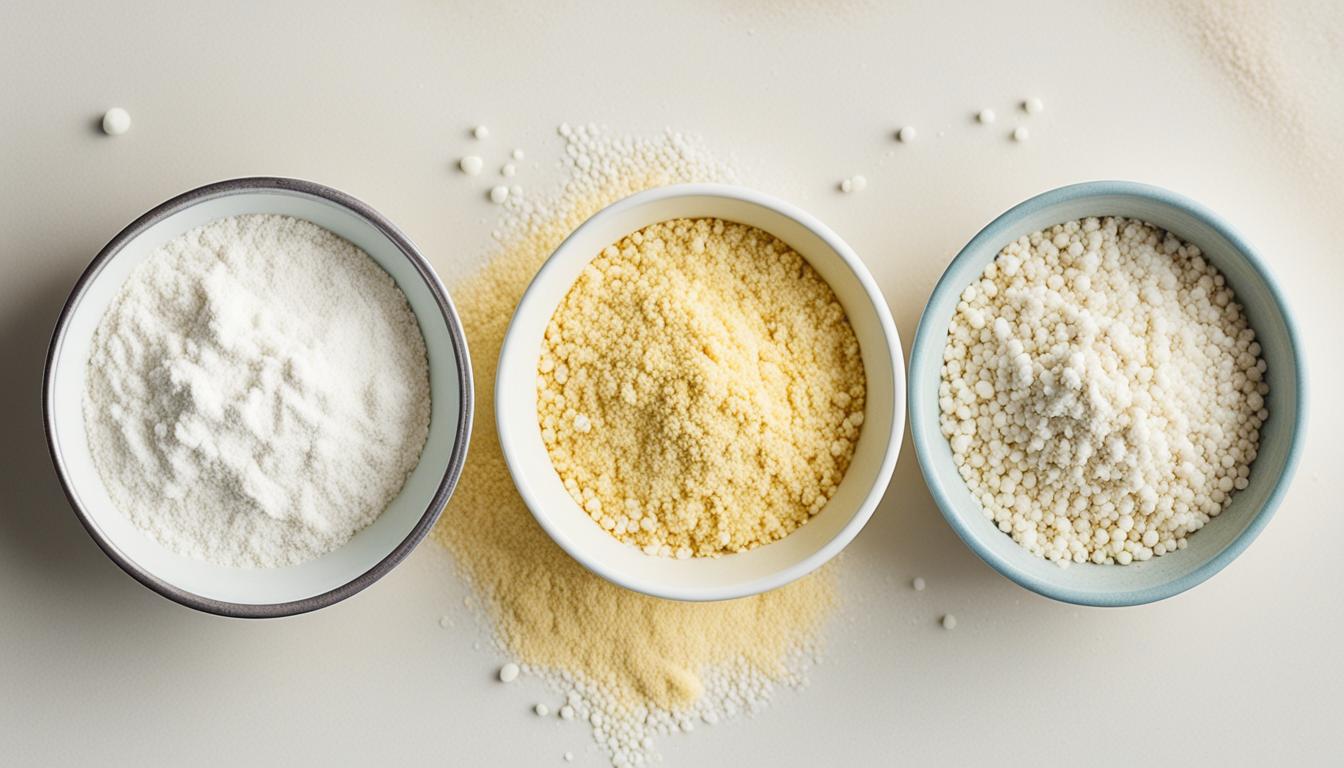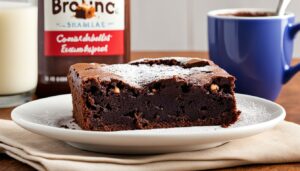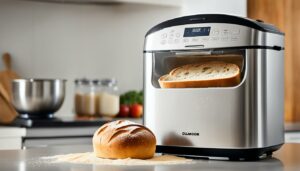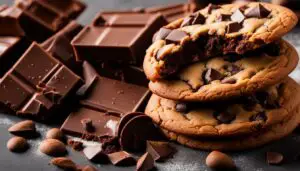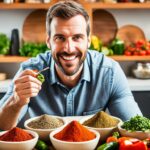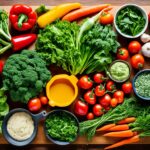Leavening agents, such as baking soda, baking powder, and yeast, are key players in the world of baking. They make our cakes rise, our bread fluffy, and our pastries light and airy. But, have you ever wondered if it’s possible to use more than one type of leavener in a recipe? Can a recipe have more than one kind of leavener? Let’s delve into the fascinating realm of multi-leavener recipes and find the answer!
Contents
- 1 Understanding Leaveners in Baking
- 2 Benefits of Using Multiple Leaveners
- 3 Experimenting with Different Leavening Agents
- 4 How to Substitute Leavening Agents in Recipes
- 5 Tips for Successful Leavening in Recipes
- 6 Baking Powder vs. Baking Soda vs. Yeast
- 7 Scaling Recipes with Multiple Leaveners
- 8 Limitations of Scaling Recipes with Leaveners
- 9 Tips for Scaling Recipes Successfully
- 10 Conclusion
- 11 FAQ
- 11.1 Can I use more than one type of leavener in a recipe?
- 11.2 What are the most common leavening agents used in baking?
- 11.3 What does baking soda do in baking?
- 11.4 How does baking powder differ from baking soda?
- 11.5 What role does yeast play in baking?
- 11.6 What are the benefits of using multiple leaveners in baking?
- 11.7 How can I experiment with different leavening agents?
- 11.8 Can I substitute leavening agents in a recipe?
- 11.9 What are some tips for successful leavening in recipes?
- 11.10 Can I use multiple leaveners when scaling a recipe?
- 11.11 What are the limitations of scaling recipes with leaveners?
- 11.12 What tips can help me scale recipes successfully?
- 12 Source Links
Key Takeaways:
- Using multiple leaveners can provide a more complex flavor profile and enhanced texture in baked goods.
- Experimenting with different leavening agents allows for innovation and delicious creations.
- Scaling recipes with multiple leaveners requires careful adjustments and consideration of the chemistry involved.
- Accurate measurement and understanding of leavening agents’ properties are crucial for successful results.
- By following proper techniques and guidelines, bakers can confidently explore the possibilities of multi-leavener recipes.
Understanding Leaveners in Baking
In the world of baking, leavening agents are the unsung heroes responsible for creating light, fluffy, and delicious baked goods. These agents are substances that produce fermentation in dough or batter, causing them to rise and take on their delightful textures. The three most commonly used leavening agents in baking are baking soda, baking powder, and yeast.
Baking Soda:
Baking soda, also known as sodium bicarbonate, is an alkaline compound. When combined with acidic ingredients like lemon juice, buttermilk, or yogurt, baking soda creates a chemical reaction that releases carbon dioxide gas. The carbon dioxide gas forms bubbles, which cause the dough or batter to rise, resulting in light and airy baked goods.
Baking Powder:
Baking powder is a combination of baking soda, an acid (usually cream of tartar), and a moisture control agent (usually cornstarch). Unlike baking soda, which requires an acidic ingredient to activate it, baking powder already contains the necessary acid. This means that it can react with both liquids and heat. Baking powder releases carbon dioxide gas in two stages: first, when it combines with liquid, and second, when exposed to heat. This double action makes baking powder a versatile leavening agent used in a variety of recipes.
Yeast:
Yeast is a living microorganism, specifically a single-celled fungi. It feeds on natural sugars present in the dough or batter, converting them into carbon dioxide and alcohol through a process called fermentation. The carbon dioxide gas produced during fermentation gets trapped in the dough, causing it to rise. Yeast is commonly used in bread and other yeast-based baked goods, imparting a distinct flavor and creating a soft, elastic texture.
Understanding how these leavening agents work is crucial for achieving successful baking results. Each leavener has its unique properties and is suitable for different types of baked goods. Whether using baking soda, baking powder, or yeast, bakers can harness the power of these leavening agents to create a wide array of delightful treats.
Benefits of Using Multiple Leaveners

Using multiple leaveners in a recipe can offer several benefits. Firstly, it can provide a more complex flavor profile, as different leaveners may react differently and add unique tastes to the final product. Secondly, combining leaveners can enhance the texture of baked goods, resulting in a lighter and more tender crumb. Additionally, using multiple leaveners can provide a more reliable rise, as different leavening agents may have varying reaction times and temperature sensitivities.
When different leaveners are combined, their individual reactions can create a harmonious blend of flavors that elevate the taste of your baked creations. For example, using both baking powder and baking soda can balance the acidity of certain ingredients while imparting a subtle tanginess. This dynamic flavor combination can be particularly beneficial in recipes like buttermilk pancakes or chocolate cakes, where a delicate balance of sweetness and acidity is desired.
In terms of texture, the use of multiple leaveners can result in a lighter and more tender crumb in various baked goods. For instance, when baking a classic pound cake, incorporating both baking powder and baking soda can contribute to a soft and moist texture. The combination of leaveners helps create fine air pockets throughout the batter, resulting in a light and delicate crumb that melts in your mouth.
“Using multiple leaveners in baking can unlock a world of possibilities by introducing new flavors and textures to your favorite recipes.” – Emily Smith, Pastry Chef
Furthermore, relying on multiple leaveners can provide a more reliable rise in baked goods. Each leavening agent has its own reaction time and temperature sensitivity. By using a combination of leaveners, the chances of achieving the desired rise and consistency are increased. This can be particularly advantageous in cases where a specific leavener may not be sufficient to achieve the desired results, such as when making high-rising bread or pastries.
When incorporating multiple leaveners, it is important to understand the interaction between them and the overall chemistry of the recipe. Adjusting the quantities of each leavener and considering their individual reaction times will help ensure optimal results. Additionally, experimenting and testing different combinations of leaveners can lead to exciting discoveries and unique baked creations.
| Benefits of Using Multiple Leaveners in Baking |
|---|
| Enhanced flavor profile |
| Improved texture and tenderness |
| More reliable rise |
Experimenting with Different Leavening Agents
Bakers who are eager to explore the possibilities of using multiple leaveners can experiment with different combinations. For example, they can try combining baking powder and baking soda in a recipe to harness the benefits of both chemical leaveners. Another option is to incorporate yeast along with baking powder to achieve a more substantial rise and a unique flavor profile. By adjusting the quantities of each leavener and carefully considering how they interact, bakers can create innovative and delicious baked goods.
So how do different combinations of leavening agents affect the final product? Let’s take a look at a comparison table to understand the effects:
| Leavening Agents | Flavor | Texture | Rise |
|---|---|---|---|
| Baking Powder and Baking Soda | Subtle tanginess from the acidic reaction | Light and airy crumb | Reliable and moderate rise |
| Yeast and Baking Powder | Rich and complex flavors from fermentation | Moist and tender crumb | Significant rise with yeast’s fermentation process |
“Experimenting with different leavening agents opens up a world of possibilities in baking. By combining baking powder and baking soda or incorporating yeast along with baking powder, bakers can create a wide range of flavors and textures that elevate their recipes.”
It’s important to note that when experimenting with leavening agents, it’s best to start with small batches and carefully record the results. This way, bakers can make adjustments and refine their recipes for future baking endeavors. Additionally, it’s crucial to understand the specific characteristics of each leavener and how they interact with other ingredients in the recipe.
How to Substitute Leavening Agents in Recipes
In some cases, bakers may need to substitute leavening agents in a recipe due to dietary restrictions or ingredient availability. When substituting baking soda for baking powder, it is important to remember that baking soda requires an acid to activate it. This means that an acidic ingredient should be included in the recipe or added separately. If using yeast as a substitute, bakers should consider the differences in rising time and adjust the recipe accordingly. Additionally, the quantity of the substitute leavener may need to be modified to ensure proper rising and flavor balance.
Here are some tips for substituting leavening agents in recipes:
- When substituting baking soda for baking powder, use a 1:3 ratio (1 part baking soda to 3 parts baking powder) as baking powder contains additional ingredients like acid and moisture control agents.
- Add an acidic ingredient, such as lemon juice, buttermilk, or vinegar, to the recipe when substituting baking soda to ensure proper activation.
- Consider the rising time of yeast when substituting for other leavening agents. Adjust the recipe accordingly to allow for longer rising times.
- Keep in mind that substituting leavening agents may affect the flavor and texture of the final baked goods. Experimentation is key to finding the right balance.
Tip: When substituting leavening agents, it’s always a good idea to test a small batch or make adjustments gradually to avoid any major disappointments. Remember, baking is both an art and a science!
By understanding the characteristics of different leavening agents and experimenting with substitutions, bakers can adapt recipes to suit their specific needs without compromising on taste and texture.
Example Recipe Substitutions
Here’s an example of how you can substitute leavening agents in a recipe:
| Original Recipe | Substituted Recipe |
|---|---|
| 1 tsp baking powder | 1/4 tsp baking soda + 1/2 tsp cream of tartar |
| 1 cup buttermilk | 1 cup milk + 1 tbsp lemon juice |
| 2 1/4 tsp active dry yeast | 1 tsp baking powder + 1/2 tsp baking soda |
Remember to adjust the quantities and follow any additional instructions provided in the substituted recipe to achieve the best results. Happy baking!
Tips for Successful Leavening in Recipes
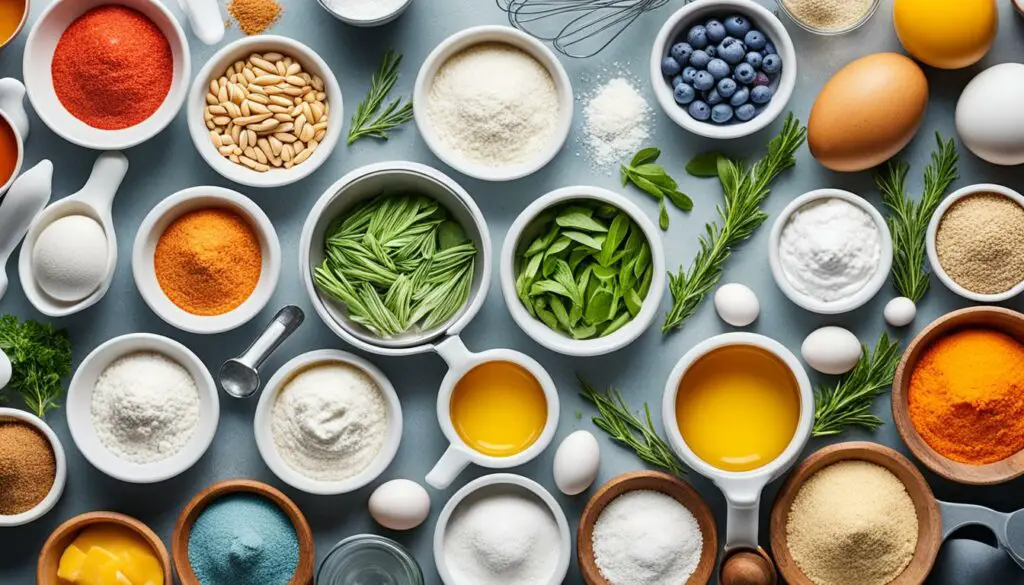
To achieve successful leavening in recipes, bakers should follow a few essential tips:
1. Accurate Measurement
Measure leavening agents accurately, as small quantity variations can significantly impact the final results. Use precise measuring spoons or a kitchen scale to ensure accuracy.
2. Ideal Ratios
Understand the ideal ratios of leavening agents in recipes. For example, use no more than 1 & 1/2 tsp of baking powder per cup of flour. Follow recipe instructions closely to maintain the proper balance of ingredients.
3. High Altitude Baking
When baking at high altitudes, adjustments to the amount of leavening agents may be necessary. Higher altitudes can affect the rising process, so it’s important to make appropriate modifications to achieve the desired result.
4. Freshness Test
Properly test the freshness of baking powder and baking soda. These leavening agents lose their potency over time, so it’s crucial to ensure they are still active. To check if baking powder is fresh, mix 1 teaspoon with 1/3 cup of hot water. If it bubbles vigorously, it is still active. For baking soda, mix 1/4 teaspoon with 2 teaspoons of vinegar. If it fizzes, it is still active.
5. Preheating and Incorporating Air
Preheat the oven to the required temperature before baking. This ensures that the leavening agents start working immediately upon entering the oven. Additionally, incorporate air into the batter or dough through methods like creaming butter and sugar or beating eggs. This helps create a lighter texture in the final baked goods.
| Tips for Successful Leavening in Recipes |
|---|
| 1. Accurate Measurement |
| 2. Ideal Ratios |
| 3. High Altitude Baking |
| 4. Freshness Test |
| 5. Preheating and Incorporating Air |
Baking Powder vs. Baking Soda vs. Yeast

Baking powder is a compound leavener that combines baking soda, an acid (such as cream of tartar), and a moisture control agent (such as cornstarch). Unlike baking soda, which requires an acidic ingredient to activate it, baking powder reacts with both liquids and heat in two stages to achieve leavening. The first reaction occurs when the baking powder is mixed with the wet ingredients, while the second reaction occurs in the oven when heat is applied. This two-stage reaction allows for more controlled and prolonged leavening. Baking powder is typically used in recipes that do not contain acidic ingredients or require a longer rise time.
Yeast:
Yeast is a living microorganism that undergoes fermentation. It feeds on sugars and produces carbon dioxide and alcohol as byproducts. This release of carbon dioxide gas causes the dough to rise, resulting in light and fluffy bread and bakery items. Yeast is commonly used in yeast bread recipes and requires time to activate and ferment before baking. It provides a unique flavor profile and a distinct texture to the final product.
In summary, baking powder and baking soda are chemical leaveners that create leavening through different reactions, while yeast utilizes fermentation to achieve a rise. Understanding the characteristics and uses of these leaveners can help bakers choose the right option for their desired outcome and create delicious baked goods.
Scaling Recipes with Multiple Leaveners
When it comes to scaling recipes that incorporate multiple leaveners, it’s important for bakers to consider the proportionate ratios of these leavening agents. While it may be tempting to double the leavening agents in a recipe, this approach may not always yield the desired results and can potentially affect the texture and taste of the final baked goods.
Instead, bakers should approach scaling recipes with multiple leaveners with caution and carefully adjust the quantities of each leavener used. It’s essential to consider the other ingredients in the recipe and the overall chemistry of the mixture. This thoughtful approach to scaling will help maintain the balance and integrity of the recipe.
Experimentation plays a crucial role in achieving successful results when scaling recipes with multiple leaveners. By testing different ratios of leavening agents and monitoring the outcomes, bakers can fine-tune their recipes and create delicious baked goods.
Remember, every recipe is unique, and the interaction between ingredients can vary. Therefore, it’s essential to take a flexible approach and adapt the scaling method to each specific recipe. With practice and attention to detail, bakers can confidently navigate the challenges of scaling recipes with multiple leaveners.
Tips for Scaling Recipes Successfully
- Accurately measure all the ingredients to maintain consistency.
- Adjust the quantities of leavening agents based on the desired yield.
- Test the final product for quality and texture to ensure a successful outcome.
- Consult reliable baking resources and recipe references for guidance.
| Leavener | Quantity | Notes |
|---|---|---|
| Baking Soda | Varies depending on acidity of other ingredients | Needs an acid to activate |
| Baking Powder | No more than 1 & 1/2 tsp per cup of flour | Contains baking soda, acid, and moisture control agent |
| Yeast | Follow recipe instructions | Requires rising time and fermentation |
“Scaling recipes with multiple leaveners requires attention to detail and consideration of the specific recipe’s chemistry.”
Limitations of Scaling Recipes with Leaveners
While scaling recipes with multiple leaveners is possible, it is important to be aware of certain limitations. The quantity of leavening agents used can greatly impact the final outcome of baked goods.
Increasing the leavening agents too much can lead to over-rising, resulting in a collapsed or unpleasantly textured final product. On the other hand, decreasing the leavening agents may result in insufficient rise and denser baked goods.
When scaling recipes with leaveners, it is crucial to understand the role of leaveners in each specific recipe and consider their interactions with other ingredients. Careful measurements and adjustments are key to avoiding potential pitfalls and achieving desired results.
To illustrate the limitations of scaling recipes with leaveners, let’s consider an example:
| Recipe | Original Quantity | Adjusted Quantity (Scaled by 2x) |
|---|---|---|
| Flour (cups) | 2 | 4 |
| Baking Soda (tsp) | 1 | 2 |
| Baking Powder (tsp) | 1 | 2 |
| Salt (tsp) | 1/2 | 1 |
| Sugar (cups) | 1 | 2 |
| Milk (cups) | 1 | 2 |
| Butter (cups) | 1/2 | 1 |
In this example, the recipe was scaled by doubling the quantities. However, doubling the leavening agents without considering the other ingredients can result in an imbalanced recipe. The excessive amount of leaveners can cause the baked goods to rise too much and create an undesirable texture.
Therefore, it is crucial to carefully adjust the quantities of leavening agents while also considering the proportions of the other ingredients and the overall chemistry of the recipe.
By being mindful of these limitations and making appropriate adjustments, bakers can navigate the challenges of scaling recipes with leaveners and achieve delightful and consistent results.
Tips for Scaling Recipes Successfully
Scaling recipes with multiple leaveners requires attention to detail and careful consideration. To ensure consistent and delicious results, here are some useful tips to follow:
- Accurately measure the ingredients: Precision is essential when scaling recipes. Be sure to measure all ingredients accurately using measuring cups or a digital scale for greater precision.
- Adjust leavener quantities: When scaling a recipe, it’s crucial to adjust the quantities of leavening agents based on the desired yield. Doubling or halving the leaveners may not always yield the desired results, so experiment and find the right balance.
- Test the final product: After scaling a recipe, always test the final product for quality and texture. This step allows you to make any necessary adjustments before serving or sharing your baked goods.
- Consult reliable baking resources: Reliable baking resources, such as cookbooks or trusted baking websites, can provide valuable insights and guidance when scaling recipes with multiple leaveners.
Remember, scaling recipes is a skill that improves with practice and experimentation. By following these tips and learning from each experience, bakers can achieve consistent and delicious results when scaling recipes with leaveners!
Conclusion
In conclusion, the utilization of multiple leaveners in a recipe can greatly enhance the flavor, texture, and rise of baked goods. By experimenting with various combinations of leavening agents such as baking soda, baking powder, and yeast, bakers can unlock new levels of creativity and bring delicious innovation to their recipes.
However, it is crucial to approach the use of multiple leaveners with care and precision. Accurate adjustment and measurement of the quantities of each leavener are essential to ensure successful baking results. Scaling recipes that incorporate multiple leaveners requires close attention to detail, considering the specific chemistry and proportions of the recipe.
With practice and a solid understanding of leavening agents, bakers can confidently navigate the realm of multi-leavener recipes and create mouthwatering treats that delight the taste buds. So go ahead, explore the possibilities, and let your imagination soar as you uncover the wonders of using multiple leaveners in your baking journey.
FAQ
Can I use more than one type of leavener in a recipe?
Yes, it is possible to use multiple leaveners in a recipe.
What are the most common leavening agents used in baking?
The most common leavening agents used in baking are baking soda, baking powder, and yeast.
What does baking soda do in baking?
Baking soda reacts with acidic ingredients to produce carbon dioxide gas, resulting in a light and airy texture.
How does baking powder differ from baking soda?
Baking powder contains baking soda, an acid, and a moisture control agent. It reacts with both liquids and heat in two stages to achieve leavening.
What role does yeast play in baking?
Yeast undergoes fermentation and converts sugars into carbon dioxide and alcohol, creating a rise in yeast bread and bakery items.
What are the benefits of using multiple leaveners in baking?
Using multiple leaveners can provide a more complex flavor profile, enhance the texture of baked goods, and ensure a more reliable rise.
How can I experiment with different leavening agents?
You can try combining baking powder and baking soda or incorporating yeast along with baking powder in a recipe.
Can I substitute leavening agents in a recipe?
Yes, you can substitute leavening agents, but it is important to consider the requirements of each substitute and make adjustments accordingly.
What are some tips for successful leavening in recipes?
Accurate measurements, understanding ideal ratios, freshness testing, and incorporating air into the batter are essential tips for successful leavening.
Can I use multiple leaveners when scaling a recipe?
Yes, it is possible to use multiple leaveners when scaling a recipe, but careful adjustment and consideration of ratios are necessary.
What are the limitations of scaling recipes with leaveners?
Scaling recipes with leaveners can lead to over-rising or insufficient rise if the quantities of leavening agents are not adjusted properly.
What tips can help me scale recipes successfully?
Accurate measuring, adjusting leavener quantities, and testing the final product are important tips for scaling recipes successfully.

